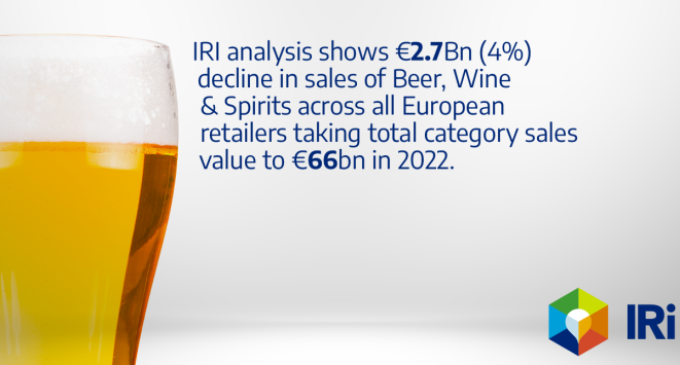IRI reports €2.7 billion alcohol sales slump as Europeans cut discretionary purchases to moderate the impact of inflation

The latest analysis from IRI, the data and analytics firm for FMCG brands and Retailers, reveals a €2.7 billion slump in sales of beer, wines and spirits across all European retailers (supermarkets, discounters, convenience stores and off-licenses) for the full year 2022. Forensically unpacking the impact of the pandemic, inflation and the cost-of-living crisis on over 230 FMCG categories, 2000+ product segments and over a 100 million SKUs sold to consumers in the largest European markets (France, Italy, Germany, Spain, Netherlands and the UK), IRI’s FMCG Demand Signals reports provide insight into consumer purchase trends.
In 2020, alcohol sales (by value) increased 12.6%, driven by consumer demand during the first year of the pandemic as people were confined to their homes and had virtually stopped eating and drinking at food service venues out of home. This added an extra €7.5 billion to the off-trade alcohol sector bringing total category sales to €67.3 billion.
During 2021, as lockdown restrictions eased, sales effectively ‘returned to normal’. Although a marginal 0.7% value sales increase added €500 million to the category in Europe, this did not compare to the surge in 2020 and was an early indicator of unsustainable sales growth.
“It is increasingly evident that underlying demand has changed in response to post-pandemic trends with new consumption patterns and choices impacting how the category grows over the next few years,” commented Ananda Roy, Global SVP, Strategic Growth Insights, IRI. “Alcohol brands are caught in a perfect storm with no end in sight. Alcohol sales tend to peak during a recession as consumers eat in instead of out. However, this recession is fueled by a perfect storm of exceptionally high food and energy prices, record interest rate rises and anaemic wage growth. Households are having to make trade-offs to moderate its impact on their available income, prioritising food staples and small indulgent treats over discretionary items like Alcohol. Alcohol sales are now lower than pre-pandemic levels.”
As the price of all groceries are predicted to remain high during 2023, IRI predicts that alcohol sales – both at home and at out-of-home venues – are unlikely to grow without investment in new products tailored to new consumer needs and consumption moments that make the category relevant again.
Zero or Low Alcohol bucking the trend in the UK
Sales of zero and low alcohol products in the UK reported a 3.7% growth in volume sales to 5 million litres in 2022 (compared to the previous year) which was a 15% decline in units as shoppers bought larger, more expensive packs. Value sales in 2022 grew 5.3% to £16 million.The segment is estimated to have a 1% share of the total BWS category. IRI predicts that with a greater variety of options available to shoppers, and space growing at the big supermarket chains, sales will increase this year, particularly as promotional events such as Dry January gain momentum. The challenge for brands is how to grow sales without cannibalizing alcohol sales that deliver significantly greater profits.
The No/Low category is not yet a revenue driver for major retailers in comparison to the total BWS category, but they are keen to support innovative ranges that are key to long-term growth and category dominance and as such are expanding their range and shelf space. With 61% of consumers saying they want better choices in zero and no alcohol drinks, the opportunity for brands and retailers to innovate in flavours, mixes and experience will continue to fuel growth in 2023 and 2024.
Champagne, prosecco and ready to drink resilient to recessionary decline
Sales of champagne and prosecco remain resilient to the overall decline in alcohol sales as people resist giving up on the sparkle of their special and celebratory occasions with family and friends after two years of restrictions and with the cost of out of home drinking stubbornly high. Consumers are opting to ‘stay in’ on weekends to drink with friends pushing up sales of ready-to-drink spirits (in lieu of cocktails at bars) as well as multi-pack servings of well-known beer brands.
“Consumers may change the specific champagne, prosecco or sparkling wine brands they buy and where they buy them in order to achieve some cost savings,” added Ananda Roy, “but they still want a treat to mark special occasions even if this means purchasing Champagne and Prosecco at discounter chains rather than mainstream supermarkets. The switch to Private Labels brands in these specific segments is still in its infancy.”
Ready to drink sprits are also staying strong against the turning tide in alcohol. These drinks are particularly popular amongst younger generations as a pre-party or ‘pre-out out’ tipple that they can drink at home without needed to mix their own cocktails.
Retailers increase promotions
Retailers, keen to protect volume sales and consumer footfall, have increased promotions on alcohol more than any other FMCG category. This is particularly notable in the UK where HFSS rules have taken hold and alcohol promotions have replaced confectionery and sugar snacks on end-of-aisle offers.
Retailers’ own labels account for 16.4% or £11 billion of value sales for the category. Although growth of Private Labels has not been as significant as in other categories, IRI believes that retailers may focus on the zero and no alcohol trend to increase private label penetration, especially though collaborations with small and artisanal brands as evidenced by Brewdog’s IPA collaboration with Aldi.
According to Ananda Roy, “Retailers are likely to raise prices in 2023, which may soften demand, particularly in the UK and Germany, where shoppers have been hardest hit by the cost of living crisis. When it comes to alcohol, strong brand equity usually keeps shoppers buying their favourite beer, wine and spirit brands. However, as prices rise we could also expect to see more people switching to private label brands as they do in other categories where they are perceived as good as national brands.”

































